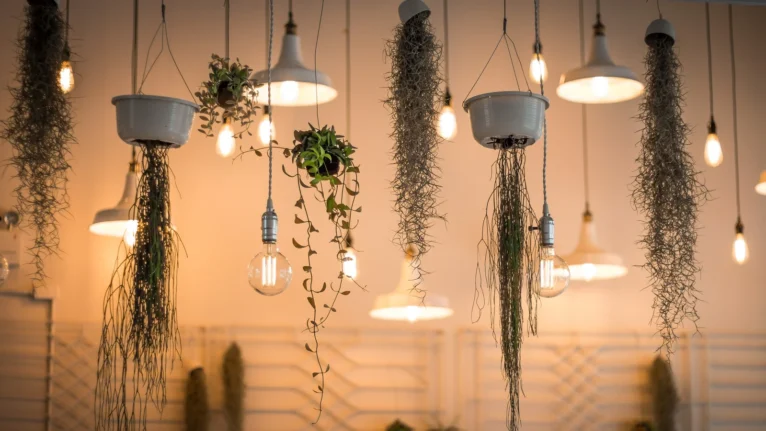Light is one of the most powerful tools in interior design. It can influence mood, define function, and shape the perception of space. Whether streaming naturally through a picture window or softly glowing from an artful fixture, lighting sets the tone of a room. Yet, it’s often underestimated or treated as an afterthought. In this guide, we explore how to design with both natural and artificial light in mind—creating interiors that feel brighter, more balanced, and tailored to how people live and feel.
Why Lighting Matters in Interior Design
- Defines the room’s functionality (e.g., reading, cooking, relaxing)
- Shapes emotional atmosphere (calming, energizing, cozy, focused)
- Highlights design features (art, textures, focal points)
- Enhances visual comfort (reduces strain, eliminates harsh contrasts)
- Alters perception of space (makes rooms feel larger, ceilings higher, or zones cozier)
Types of Lighting and Their Roles
Designers use a layered approach with three core types of light:
1. Ambient Lighting (General Lighting)
The base layer of light that provides overall illumination.
- Examples: ceiling fixtures, recessed lights, wall-mounted sconces
- Goal: illuminate entire room evenly
2. Task Lighting
Focused lighting to support activities like reading, cooking, or working.
- Examples: desk lamps, under-cabinet lights, pendant lights
- Goal: eliminate shadows and reduce eye strain
3. Accent Lighting
Used for decoration and emphasis.
- Examples: LED strips, track lighting, picture lights, uplights
- Goal: highlight specific areas or features (e.g., artwork, architectural elements)
Table: Light Type Comparison
| Lighting Type | Purpose | Best Fixtures | Ideal Rooms |
|---|---|---|---|
| Ambient | General illumination | Ceiling lights, wall sconces | Living rooms, bedrooms |
| Task | Focused work lighting | Desk lamps, under-cabinet | Kitchens, offices, reading nooks |
| Accent | Aesthetic enhancement | Track lighting, LEDs, uplights | Entryways, hallways, art walls |
Designing with Natural Light
Natural light shifts throughout the day and impacts room color, energy, and mood.
Consider Orientation:
- North-facing rooms: Soft, consistent light—great for studios and bedrooms
- South-facing rooms: Bright and warm—ideal for living spaces
- East-facing rooms: Gentle morning light—great for kitchens or breakfast nooks
- West-facing rooms: Strong evening light—best for dining areas or lounges
Ways to Maximize Natural Light:
- Use sheer or light-filtering curtains
- Place mirrors opposite windows to reflect light
- Choose reflective finishes (e.g., glossy tiles, lacquered furniture)
- Keep window areas uncluttered
Choosing the Right Artificial Light Fixtures
1. Ceiling Fixtures
Great for ambient lighting. Choose based on ceiling height and room size:
- Flush-mount: for low ceilings
- Chandeliers or pendants: for dramatic effect
2. Wall Lights
Provide ambient or accent light, depending on placement.
- Ideal in hallways, bathrooms, or beside beds
3. Floor and Table Lamps
Add style and function. Easy to reposition.
- Layer with overhead lights to create depth
4. LED Strip Lighting
Used under shelves, behind headboards, or under cabinetry.
- Great for creating mood and highlighting features
5. Recessed Lighting
Unobtrusive and versatile. Can provide both ambient and accent light.
- Use with dimmers for flexibility
Color Temperature and Mood
Lighting temperature is measured in Kelvins (K) and affects the feel of a space.
- Warm Light (2700K–3000K): Soft, cozy — ideal for bedrooms, living rooms
- Neutral Light (3500K–4100K): Clear, natural — great for kitchens, bathrooms
- Cool Light (5000K–6500K): Bright, focused — best for offices or task areas
Tip:
Mix temperatures in open-plan spaces to define zones and create ambiance.
Smart Lighting Systems
Modern lighting design includes smart tech for convenience and customization.
- Schedule lights to align with natural rhythms
- Use voice or app controls to adjust brightness or color
- Create “scenes” for tasks, relaxation, or entertaining
Popular smart brands: Philips Hue, LIFX, Nanoleaf, Lutron Caseta
Lighting by Room
Living Room
- Use a combination of ceiling fixtures, floor lamps, and accent lights
- Highlight bookshelves or art with wall-mounted lighting
Kitchen
- Prioritize task lighting over prep zones
- Add pendant lights over islands or dining tables
- Use under-cabinet lighting for countertops
Bedroom
- Use bedside lamps or sconces for reading
- Install dimmable overhead fixtures for mood lighting
- Consider LED tape lighting under beds or behind headboards
Bathroom
- Avoid shadows near mirrors with side-mounted sconces
- Use overhead lighting for general illumination
- Choose fixtures with moisture protection
Home Office
- Use adjustable desk lamps
- Avoid harsh overhead lights that create glare
- Layer ambient with task lighting for comfort
Common Lighting Mistakes
- Relying on a single light source
- Over-illuminating rooms
- Placing fixtures without considering furniture layout
- Ignoring dimmer switches
- Forgetting to match bulb temperature across fixtures
Tips for Cohesive Lighting Design
- Choose lighting fixtures that match your design style (e.g., industrial, coastal, modern)
- Repeat materials (metal, glass, fabric) for consistency
- Use similar finishes for switches, sconces, and ceiling lights
- Keep scale appropriate to room size
Sustainable Lighting Practices
- Choose LED bulbs (use 75% less energy than incandescent)
- Use occupancy sensors in closets or hallways
- Install daylight sensors for porch or exterior lights
- Opt for ENERGY STAR-rated fixtures
Great lighting design is not just about brightening a room—it’s about shaping how that room is experienced. With the right combination of natural and artificial lighting, you can enhance function, highlight beauty, and create a space that feels exactly the way you want it to feel. Whether you’re designing a cozy reading corner or illuminating an entire open-concept home, lighting is your silent partner in great interior design.
Don’t leave it for last. Plan with light in mind from the start—and let your space shine.


Leave a Reply